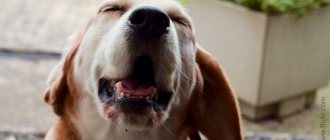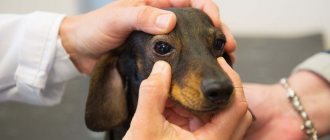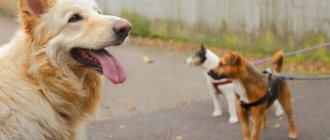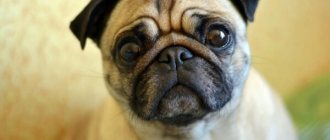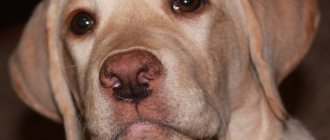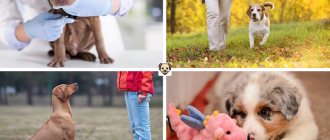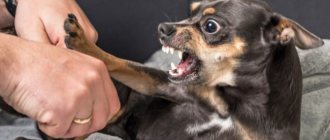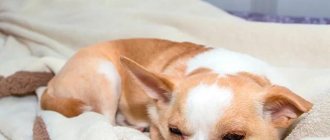The mucous membrane of the upper respiratory tract - the nose and nasopharynx - communicates with the external environment and is therefore very susceptible to various irritants and allergens. It is also the first to react to the penetration of airborne pathogens and airborne infections into the body.
The body of dogs and other highly organized animals reacts to the penetration of foreign particles into the respiratory tract by sneezing. This reaction allows you to get rid of them and restore normal breathing. If the puppy sneezed once, then this is most likely only a mechanical cleaning of the respiratory tract from infiltrated debris. But if this happens many times in a row, the pet snorts, sniffles, coughs, then this may indicate an illness. This condition requires immediate medical attention. In this article we will look at why a dog sneezes, what the treatment is in each specific case, and what preventive measures exist.
Causes of the disease
Seeing that the dog is sneezing, the owners wonder what to do? There are different reasons for sneezing. Methods of providing medical care to an animal in each specific case must be selected individually.
Here are the most common reasons:
- entry of foreign bodies into the nose and nasopharynx;
- injury to the mucous membrane of the upper respiratory tract;
- entry of irritating substances into the respiratory tract;
- polyps or tumors of the nasal and nasopharyngeal mucosa;
- allergic reactions;
- colds and infectious diseases;
- hypothermia of the body;
- heart problems.
Attention
Sometimes dogs "fake sneeze" to get attention or show interest in play.
If your dog sneezes while eating or while walking, chances are he is faking it to get what he wants.
When a dog imitates a sneeze, they will typically watch you as they sneeze to make sure they get your attention. They may even come closer and sneeze on or near you, so you can't ignore them.
Entry of foreign bodies into the nose and nasopharynx
If a dog sneezes once, most often this indicates that dust or other airborne particles have entered the animal’s nasal passages. Perhaps this is sand, earth, plant seeds that got into the nasal passages while exploring the area. A single act of sneezing allows the animal to perform mechanical cleaning of the nose and nasopharynx.
A more serious situation occurs if a foreign object is stuck in the respiratory tract. This happens when a dog sneezes and snorts and starts rubbing its nose with its paw. In the case when nosebleeds occur, there is a high probability that the nasal passages are injured by a foreign object. Injury can also occur during a blow or fight.
If sneezing does not bring relief, the owner should examine the dog's respiratory tract and try to remove the foreign object. If necessary, you should seek veterinary help at a specialized clinic.
Treatment
Treatment should be prescribed by a veterinarian after an in-person examination of the dog.
Because in order to take action for the dog’s recovery, it is necessary to determine the cause of the disease, and this is not always possible at home.
What to do before visiting the clinic?
First, examine your nasal passages. It is advisable to use a flashlight to illuminate your nose. This way you can detect foreign objects if there are any. Also, you will immediately see if there is swelling and redness; these are the first signs of inflammation.
Remove dirt and crusts around the nose using a cotton pad moistened with plain warm water.
To reduce inflammation, it is safe to use Anandin drops or a 0.15% Maksidin solution, one drop in each nostril. These drops are a complex preparation against bacteria. Helps relieve swelling and promotes tissue healing.
If after a couple of days the sneezing does not go away, does not become weaker, and the dog exhibits other symptoms - lethargy, loss of appetite, fever, you should immediately consult a doctor. There is always a danger that the dog has contracted a viral infection, which is very dangerous for the pet’s life!
Formation of polyps or tumors in the nose and nasopharynx
Neoplasms in the nasopharynx produce similar symptoms. The dog sneezes many times in a row, shakes its head, and there may be bloody discharge (sometimes mixed with pus). There is often difficulty in nasal breathing. The dog sniffles and breathes intensely. This means that oxygen starvation begins. In this case, the dog’s body needs urgent help.
Professional diagnosis of this condition can only be carried out in a veterinary clinic. Using radiography, the presence of benign or malignant neoplasms is determined, and its nature is determined by taking material for a biopsy. Treatment is predominantly surgical. If the neoplasm is malignant, the dog will need to undergo a course of chemotherapy or radiotherapy.
Allergy
The dog may be having an allergic reaction. It is quite often localized in the upper respiratory tract, since it is there that foreign particles penetrate during breathing. A number of substances that are allergens can cause it in a dog. The most common ones are the following:
- plant pollen;
- tobacco smoke;
- mold;
- household chemicals with a strong odor;
- flea collars;
- bites of blood-sucking insects.
In case of an allergic reaction, the following symptoms are usually observed:
- the dog coughs and sneezes;
- possible liquid discharge from the nose;
- sometimes lacrimation occurs;
- The mucous membranes often become inflamed, making the breathing process difficult.
Allergic dermatitis, severe asthma, and eczema can complicate the disease. Treatment consists of identifying the substance that served as the allergen, eliminating it and prescribing treatment in the form of taking antihistamines.
Playfulness
Many dogs like to sneeze when they play with other dogs or people. This "play sneeze" is normal and is used by dogs to show that they are excited and having a good time.
Dogs also use playful sneezing to show that they are being purely playful.
Dogs also tend to curl their lips during fun games. This curl of the lips creates a wrinkled nose, which can cause their body to sneeze.
A playful sneeze is typically a short snort that comes from the nose rather than the lungs.
Colds
If your dog sneezes frequently, it may have a cold. Coughing, sneezing, fever, lacrimation are the main symptoms of infectious and colds. If the virus affects the mucous membrane of the stomach and intestines, vomiting and diarrhea (stomach flu) may occur.
There is a high risk of disease during seasonal epidemics, especially if the dog is walked for a long time without special clothing during the cold season. At the same time, there are sneezing fellow tribesmen in the dog park, which makes infection inevitable. The main provoking factor for infectious diseases is the dog’s low immunity.
It is possible to avoid infection by following preventive measures:
- limit walking during epidemics (time spent on the street should not exceed 30 minutes);
- in cold weather, dress your pet in special dog clothes;
- Vaccinate it regularly (the first vaccination is done immediately after the end of the period of teeth change).
Infectious diseases are fraught with serious complications. The most dangerous of them are pneumonia, plague and leptospirosis.
Sneezes and grunts
Grunting is a typical sound made by Mastiffs, Bulldogs and related breeds (even Pugs and Pekingese). The reason is the special structure of the muzzle and respiratory apparatus. But if grunting is accompanied by coughing, shortness of breath and sneezing, this is a reason to visit the veterinarian.
Such reflexes are the cause of helminthic infestation. Roundworms settle not only in the intestines, but also live throughout the body. If the pet is restless, often vomits, scratches the anal passage, while sneezing and grunting, then there is only one conclusion - infection with helminths. Routine cleaning should be carried out using the usual preparations.
A deadly pathology is tracheal collapse (softening of the cartilaginous rings of the trachea, blocking of the larynx, lowering the softening process to the bronchi). The disease is genetic and incurable.
Sneezing and coughing are not a reason to panic. If such attacks occur regularly, the owner knows what causes them and how to get rid of them, then there is no point in going to the clinic. But if the pathology is primary, then it is better to contact a veterinarian to find out the cause.
Hypothermia of the body
Hypothermia can also result in diseases caused by pathogenic microflora of bacterial origin. The most common is rhinitis. The dog constantly sneezes, this is accompanied by green discharge from the nose with an unpleasant odor. Purulent rhinitis in dogs is treated with nasal antibiotics.
A sharp narrowing of blood vessels when leaving a warm room in the cold can also be accompanied by sneezing. Hypothermia of the body is indicated by pale mucous membranes, internal trembling, cold paws and nose. Small dogs with short hair are especially susceptible to this reaction to cold. If the dog begins to get sick, you should immediately place it in a warm place, wrap it in a blanket, and apply a warm heating pad to its limbs. This method allows the dog not to get sick if it has a strong enough immune system.
Prevention
- It is necessary to vaccinate your animal against viral diseases in a timely manner!
- The dog should have a well-equipped “place”. If she lives in a house, then she should not lie on a cold floor or draft.
- If the dog lives on the street, he must have an insulated booth. And, despite the fact that he lives in the yard, he still needs to be walked to provide sufficient exercise and socialization. Otherwise, the dog will not have sufficient immunity.
- Periodic treatments against internal and external parasites are required!
Heart problems
An older dog sometimes sneezes and coughs due to heart failure. This symptom appears especially clearly in nervous animals during periods of severe shock. Miniature poodles and pinschers are especially susceptible to this reaction. Stress is very dangerous for such dogs. Therefore, you need to monitor the condition of their cardiovascular system. It is necessary to periodically undergo a preventive examination at a veterinary clinic. Animals that begin to sneeze should have a cardiogram done to rule out heart disease.
Reverse sneeze syndrome
A condition in which a dog convulsively sucks in air is called reverse sneezing. The act of sneezing involves sharply exhaling air through the nose. With reverse sneezing, the opposite process occurs. These convulsive breathing movements are explained by the fact that part of the elongated soft palate is sucked into the windpipe when inhaling, and thus the dog tries to clear the airways. A tight collar or a strong-smelling chemical can cause reverse sneezing. Dogs of small breeds with a small trachea and a short muzzle (brachycephalic) are especially susceptible to this disorder.
Similar movements appear if the dog is choking and reflexively tries to push the foreign body out of the windpipe. In most cases, this condition occurs in healthy dogs, but sometimes it may indicate the presence of worm larvae or polyps in the windpipe. So, if reverse sneezing occurs, it is recommended that your pet be examined by an experienced veterinarian.
Sneezing is a physiological process that allows you to get rid of foreign particles or microorganisms that irritate the nasopharynx area. But, at the same time, very often sneezing is a symptom of serious diseases of the respiratory system, the consequences of which can be serious. Therefore, if there is any suspicion of pathology, it is recommended to undergo a diagnostic examination at a veterinary center.
Briefly about the main thing
- The causes of sneezing can be: allergies, infection, foreign body, local irritation, trauma, neoplasm, parasites, frontal sinusitis, stress.
- Reverse sneezing syndrome can sometimes be observed in dogs. It may look scary, but unless there are other accompanying symptoms, there is often no need to worry.
- At risk are pets with weakened immune systems and those that are often exposed to drafts and are exposed to hypothermia. As well as representatives of brachycephalic breeds.
- Treatment should be prescribed by a veterinarian after determining the cause.
- For prevention, it is necessary to vaccinate the animal in a timely manner, treat it against parasites and provide the dog with a warm “place” without drafts.
